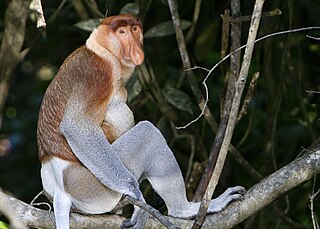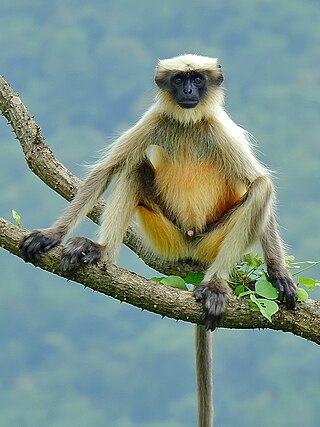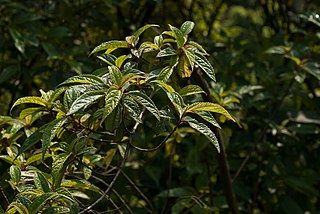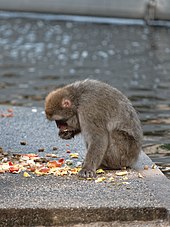
The crab-eating macaque, also known as the long-tailed macaque and referred to as the cynomolgus monkey in laboratories, is a cercopithecine primate native to Southeast Asia. A species of macaque, the crab-eating macaque has a long history alongside humans. The species has been variously seen as an agricultural pest, a sacred animal, and, more recently, the subject of medical experiments.

The rhesus macaque, colloquially rhesus monkey, is a species of Old World monkey. There are between six and nine recognised subspecies that are split between two groups, the Chinese-derived and the Indian-derived. Generally brown or grey in colour, it is 47–53 cm (19–21 in) in length with a 20.7–22.9 cm (8.1–9.0 in) tail and weighs 5.3–7.7 kg (12–17 lb). It is native to South, Central, and Southeast Asia and has the widest geographic range of all non-human primates, occupying a great diversity of altitudes and a great variety of habitats, from grasslands to arid and forested areas, but also close to human settlements. Feral colonies are found in the United States, thought to be either released by humans or escapees after hurricanes destroyed zoo and wildlife park facilities.

The proboscis monkey or long-nosed monkey is an arboreal Old World monkey with an unusually large nose, a reddish-brown skin color and a long tail. It is endemic to the southeast Asian island of Borneo and is found mostly in mangrove forests and on the coastal areas of the island.

The Barbary macaque, also known as Barbary ape, is a macaque species native to the Atlas Mountains of Algeria, Tunisia and Morocco, along with a small introduced population in Gibraltar. It is the type species of the genus Macaca. The species is of particular interest because males play an atypical role in rearing young. Because of uncertain paternity, males are integral to raising all infants. Generally, Barbary macaques of both sexes and all ages contribute in alloparental care of young.

Semnopithecus is a genus of Old World monkeys native to the Indian subcontinent, with all species with the exception of two being commonly known as gray langurs. Traditionally only the species Semnopithecus entellus was recognized, but since about 2001 additional species have been recognized. The taxonomy has been in flux, but currently eight species are recognized.

The Moor macaque is a macaque monkey with brown/black body fur with a pale rump patch and pink bare skin on the rump. It has ischial callosities, which are oval-shaped. It is about 50–58.5 cm long, and eats figs, bamboo seeds, buds, sprouts, invertebrates and cereals in tropical rainforests. It is sometimes called "dog-ape" because of its dog-like muzzle, although it is no more closely related to apes than any other Old World monkey is. It is endemic to the island of Sulawesi in Indonesia, which is an important biodiversity hotspot.

Social grooming is a behavior in which social animals, including humans, clean or maintain one another's bodies or appearances. A related term, allogrooming, indicates social grooming between members of the same species. Grooming is a major social activity and a means by which animals who live in close proximity may bond, reinforce social structures and family links, and build companionship. Social grooming is also used as a means of conflict resolution, maternal behavior, and reconciliation in some species. Mutual grooming typically describes the act of grooming between two individuals, often as a part of social grooming, pair bonding, or a precoital activity.

The toque macaque is a reddish-brown-coloured Old World monkey endemic to Sri Lanka, where it is known as the rilewa or rilawa, . Its name refers to the whorl of hair at the crown of the head, reminiscent of a brimless toque cap.

The bonnet macaque, also known as zati, is a species of macaque endemic to southern India. Its distribution is limited by the Indian Ocean on three sides and the Godavari and Tapti Rivers, along with its related competitor the rhesus macaque in the north. Land use changes in the last few decades have resulted in changes in its distribution boundaries with the rhesus macaque, raising concern for its status in the wild.

The wedge-capped capuchin or Guianan weeper capuchin is a capuchin monkey from South America. It is found in northern Brazil, Guyana and Venezuela. Cebus olivaceus is known to dwell in tall, primary forest and travel over long distances during the day.
Linda Marie Fedigan, is a Canadian-based American academic, educator, and Canada Research Chair in Primatology and Bioanthropology at the University of Calgary, Alberta. In addition, Fedigan is also the Executive Editor of the American Journal of Primatology and a fellow of the Royal Society of Canada. Prior to accepting her current position, Fedigan was a professor at the University of Alberta, teaching anthropology from 1974 until 2001.
Primates is a bimonthly peer-reviewed scientific journal of primatology, and an official journal of the Japan Monkey Center at Kyoto University. It publishes original papers that cover all aspects of the study of primates. The journal publishes original research articles, reviews, news and perspectives, and book reviews. It was established in 1957 by Kinji Imanishi. Although the first volume contained both articles in Japanese or English, subsequent volumes were published in English, thanks to a grant from the Rockefeller Foundation. It is now published by Springer and the current editor-in-chief is Masayuki Nakamichi.

The northern pig-tailed macaque is a vulnerable species of macaque in the subfamily Cercopithecidae. It is found in Bangladesh, Cambodia, China, India, Laos, Myanmar, Thailand, and Vietnam. Traditionally, M. leonina was considered a subspecies of the southern pig-tailed macaque, but is now classified as an individual species. In the 21st century, the pig-tailed macaque was split into the northern pig-tailed macaque species Macaca leonina and the Sundaland pig-tailed macaque species M. nemestrina. This reclassification was aided by the observation of sexual swellings and basic attributes that distinguish the two. The northern pig-tailed macaque is frugivorous and their social grouping is matriarchal, where sexual dimorphic traits can distinguish males and females. Their adaptation to omnivorous diets occur in periods of fruit scarcity, munching on wild vegetation and crops, human foods, and small insects and mammals. Despite their adaptability, northern-pig tailed macaques experience viral threats such as the human immunodeficiency virus type 1, pathogenic simian immunodeficiency, and coronavirus. Human impacts are also present, such as agricultural expansions, aquaculture, transportation infrastructure, hunting and logging for meat and trophies, and the illegal pet trade; that result in habitat loss, forest fragmentation, and a reduced well-being.

Girneys are soft vocalizations used by species of Old World monkeys to ease affiliative social interactions between unrelated members of the same species. The vocalizations are most commonly used by adult females around birthing season; the female will direct the call towards an unrelated mother and her offspring as an attempt to initiate friendly contact. However, mothers themselves will never direct girneys towards their own offspring as girneys do not increase affiliative interactions between relatives. Monkeys will also produce call when interacting with a dominant member of the same species, and when avoiding further conflict after becoming victim of an agonistic interaction. In all contexts, the vocalization is beneficial as it allows the signaler to inform potential aggressor that they are nonthreatening, thereby reducing the chance of attack and increasing fitness. Girneys are often accompanied by lip-smacking and a hesitant approach towards the dominant monkey. If the vocalization successfully reduces tension, it may be followed by allogrooming, alloparenting, and/or a rocking embrace.

The Yakushima macaque is a subspecies of Japanese macaque that is indigenous to Yakushima Island. It is also known as the Yaku macaque.

Sexual swelling, sexual skin, or anogenital tumescence refers to localized engorgement of the anus and vulva region of some female primates that vary in size over the course of the menstrual cycle. Thought to be an honest signal of fertility, male primates are attracted to these swellings; preferring, and competing for, females with the largest swellings.
In biology, paternal care is parental investment provided by a male to his own offspring. It is a complex social behaviour in vertebrates associated with animal mating systems, life history traits, and ecology. Paternal care may be provided in concert with the mother or, more rarely, by the male alone.

Animal non-reproductive sexual behavior encompasses sexual activities that non-human animals participate in which do not lead to the reproduction of the species. Although procreation continues to be the primary explanation for sexual behavior in animals, recent observations on animal behavior have given alternative reasons for the engagement in sexual activities by animals. Animals have been observed to engage in sex for social interaction bonding, exchange for significant materials, affection, mentorship pairings, sexual enjoyment, or as demonstration of social rank. Observed non-procreative sexual activities include non-copulatory mounting, oral sex, genital stimulation, anal stimulation, interspecies mating, and acts of affection, although it is doubted that they have done this since the beginning of their existence. There have also been observations of sex with cub participants, same-sex sexual interaction, as well as sex with dead animals.
Infanticide in non-human primates occurs when an individual kills its own or another individual's dependent young. Five hypotheses have been proposed to explain infanticide in non-human primates: exploitation, resource competition, parental manipulation, sexual selection, and social pathology.

Oreocnide pedunculata, the purple woodnettle or longpedicel woodnettle, is a species of flowering plant in the family Urticaceae, native to south-central and southern Japan, the Ryukyu Islands, and Taiwan. A shrub or small tree 2 to 5 m tall, it is found growing in valleys and forest edges at elevations from 100 to 1,200 m. Its leaves are an important food item for Formosan rock macaques and Japanese macaques.






























